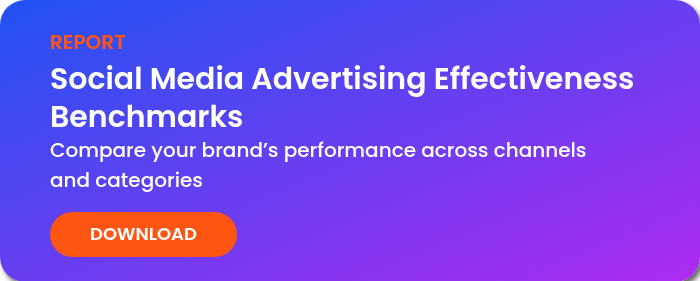Using social media metrics that matter to improve brand and performance outcomes
Social media is more than a channel—it’s a force that continues to evolve and shape how people think, feel, and buy. Once a simple tool for social connection, it’s become the most influential media driver of consumer purchases, surpassing TV for the first time, as reported in DISQO’s 2025 Consumer Trends report.
As social ad budgets grow, so does the challenge of measuring true effectiveness. Legacy platform metrics like views and engagement provide useful insights but don’t tell the whole story of how campaigns influence perception and drive action.
That’s why social media ad effectiveness benchmarks matter. Without them, it’s impossible to know how well your social campaigns perform relative to industry norms and competitors, whether your strategies drive the right outcomes, and how to allocate budgets effectively across different platforms.
To help brands leverage the value of social media advertising benchmarks, we put together this guide that answers the important questions:
- Social media’s rising role in driving consumer action
- Why use social media ad effectiveness benchmarks
- How to understand social media benchmarks based on category and brand maturity
- How to ensure trustworthy social media advertising benchmarks
- How to use social media advertising benchmarks: Key takeaways for marketers
- Measuring ad effectiveness with DISQO’s full-funnel, cross-media benchmarks
Social media's growing role in driving consumer action
Whether discovering new brands, researching products, or making purchases, social platforms are reshaping the entire path to purchase. Now more than ever, consumers exposed to social ads are significantly more likely to visit brand websites, search for competitors, and complete ecommerce transactions.
Social media’s impact at every stage of the funnel
Awareness and brand perception – Social media remains one of the strongest drivers of unaided and aided brand awareness. Consumers exposed to ads on platforms like Instagram, TikTok, and Facebook are likelier to recall and recognize brands.
Consideration and competitive search – Today’s consumers use social media to engage, evaluate, and compare brands. Campaigns that effectively target mid-funnel behaviors—such as branded searches and site visits—help companies stay top-of-mind when purchase decisions are made.
Conversion and ecommerce lift – Social advertising is also directly influencing category site visitation and ecommerce transactions. This means that a well-placed social campaign isn’t just driving clicks—it’s pushing consumers to convert.
Social media’s unique advantage in driving action
More than other traditional channels, social media enables:
Emotion-driven discovery –The mix of entertainment, content, and commerce makes brand interactions feel natural rather than intrusive, fostering higher engagement where ads are seen and drive action.
Frictionless shopping experiences – Features like in-platform purchasing, direct links, and social commerce integrations make it easier for consumers to go from discovery to checkout without leaving the platform.
Cross-platform influence –A consumer might see a brand’s ad on TikTok, search for it on Google, and buy it later on the brand’s website. Measuring this multi-touch influence is critical for understanding social media’s full impact.
Why use social media ad effectiveness benchmarks
While social media offers clear advantages, proving its impact on business outcomes is critical. Benchmarks provide an objective way to assess whether campaigns meet their goals, highlight areas for improvement, and ensure ad dollars are spent where they drive the most value.
DISQO’s Social Media Benchmarks cover 17 standardized full-funnel metrics, from favorability to purchase intent, helping advertisers put campaign performance into context. With an incremental view of how social campaigns perform across categories and compared to other channels in your media mix, brands can harness the power of deterministic real-time data to target, launch, and optimize more effectively. Key benchmark insights include:
- How social ads drive everything from brand awareness and lower-funnel actions—helping marketers move beyond vanity metrics like clicks and impressions.
- How effectiveness varies by category—revealing which industries see the strongest results from social advertising and where those results fall in the funnel.
- How social compares to other digital channels—ensuring advertisers invest where impact is highest.
- How results differ based on brand maturity—helping marketers tailor their strategies whether they’re launching a new brand or defending market share.
How to understand social media benchmarks based on category and brand maturity
Social media strategies aren’t one-size-fits-all—they vary based on a brand's category and maturity. Advertisers should evaluate their performance against relevant category and brand norms, determining how those factors shape expected outcomes.
How category impacts social ad performance
New data from DISQO’s 2025 Social Media Benchmarks reveals major differences in how social media drives consumer action across categories. While all categories benefit from social media advertising, brands should consider the following:
Consumables: Social media is a direct purchase driver, with high purchase intent. Consumers may be browsing, but they’re getting ready to buy. The keys are clear calls to action and, where possible, seamless shopping experiences that turn intent into instant action.
Goods: Competitive search and e-commerce visit rates for goods excel, proving that social is a battleground for brand switching. Marketers must focus on retargeting and differentiation to capture demand before consumers move on.
Services: While social ads generate exceptional conversion rates, awareness remains challenging. Brands in this space must first build credibility, leveraging expert endorsements, education, and retargeting to guide consumers through the funnel.
Vehicles: Social media is an underutilized opportunity in auto buying. While initial awareness is low, those who engage on social media are high-intent buyers. Brands that fail to measure cross-platform engagement risk underestimating social media’s true impact.
These differences highlight why category-specific benchmarking is essential. Simply comparing social performance to cross-channel averages can lead to misguided conclusions—brands need to understand how their category naturally performs on social before evaluating success.
How brand maturity affects social ad performance
Beyond category differences, a brand’s growth stage also plays a critical role in how social benchmarks should be interpreted:
New Brands–Social media is a powerful awareness builder, but these brands may struggle to drive immediate lower-funnel actions like search and site visits.
Emerging Brands – As familiarity grows, social media becomes a key driver of competitive research and consideration behaviors. At this stage, optimizing mid-funnel engagement is crucial.
Established Brands–Strong brand familiarity doesn’t guarantee loyalty. Benchmark data shows a rise in competitive search and site visitation, meaning established brands must stay vigilant to retain their customer base.
How to ensure trustworthy social media advertising benchmarks
Not all benchmarks are created equal—data quality matters. Advertisers need benchmarks built on broad metric coverage, a single-source methodology, and unbiased cross-platform visibility to ensure accuracy. This prevents misleading comparisons and ensures reliable insights across brand and behavioral metrics.
The best benchmarks are also recent and adaptive, reflecting shifts in consumer behavior, platform trends, and privacy changes. Outdated datasets can distort expectations, so brands should partner with providers who continuously measure and refine benchmarks to stay relevant in today’s evolving social media landscape.
How to use social media advertising benchmarks: Key takeaways for marketers
Measuring performance against competitors and the broader industry
Benchmarks provide essential context for evaluating campaign success within a brand’s category and the broader industry. By comparing performance against category norms, advertisers can determine whether they are exceeding, meeting, or underperforming expectations. This helps brands set realistic goals and align internal stakeholders around measurable outcomes.
Identifying areas for in-flight optimization or future campaigns
Social media benchmarks offer a data-driven approach to campaign refinement. If awareness is strong but engagement is low, creative strategies may need an update. If conversion rates are underperforming, adjusting targeting, retargeting, or media placement can improve results. This ensures brands focus on the right stage of the funnel, whether it’s awareness, engagement, or conversion.
Informing budget and resource allocation
Understanding which platforms and funnel stages drive the most impact allows brands to optimize media spend for efficiency. Benchmarks help identify where brands are most successful and where additional investment is needed. This strategic allocation ensures that ad budgets are directed toward high-performing channels and audience segments to maximize ROI.
Setting and socializing realistic goals
Rather than relying on arbitrary performance targets, benchmarks provide a foundation for setting data-driven objectives. Advertisers can use insights from past performance and industry standards to establish achievable yet ambitious goals that reflect real business impact. This ensures campaigns are not just measured against internal KPIs but against what’s actually possible within the competitive landscape.
Social media benchmarks aren’t just about tracking past performance—they provide a strategic roadmap for smarter decision-making, continuous optimization, and stronger brand and performance advertising outcomes.
Measuring ad effectiveness with DISQO’s full-funnel, cross-media benchmarks
Because our audience opts in to share their digital behaviors across channels—including siloed social platforms—DISQO measures ad exposure without relying on platform data. This consistent methodology ensures a clear, unbiased view of campaign impact for our clients.
DISQO’s 2025 benchmarks include:
- Data from 1650 campaigns from March 2021 through December 2024.
- Seventeen lift metrics, spanning brand awareness, favorability, and key consumer actions like site visits, search engagement, and e-commerce activity for brand, category, and competitors
Curious how your campaigns match up against our benchmarks? Download our full 2025 Ad Effectiveness Benchmarks now.





